Healthy Eating Learning Opportunities and Nutrition Education
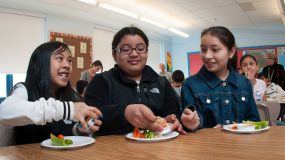
Healthy eating learning opportunities includes nutrition education and other activities integrated into the school day that can give children knowledge and skills to help choose and consume healthy foods and beverages. 1 Nutrition education is a vital part of a comprehensive health education program and empowers children with knowledge and skills to make healthy food and beverage choices. 2-8
US students receive less than 8 hours of required nutrition education each school year, 9 far below the 40 to 50 hours that are needed to affect behavior change. 10,11 Additionally, the percentage of schools providing required instruction on nutrition and dietary behaviors decreased from 84.6% to 74.1% between 2000 and 2014. 9
Given the important role that diet plays in preventing chronic diseases and supporting good health, schools would ideally provide students with more hours of nutrition education instruction and engage teachers and parents in nutrition education activities. 5, 12 Research shows that nutrition education can teach students to recognize how healthy diet influences emotional well-being and how emotions may influence eating habits. However, because schools face many demands, school staff can consider ways to add nutrition education into the existing schedule. 11
Nutrition education can be incorporated throughout the school day and in various locations within a school. This provides flexibility allowing schools to use strategies that work with their settings, daily schedule, and resources.

In the Classroom
Nutrition education can take place in the classroom, either through a stand-alone health education class or combined into other subjects including 2,5 :
- Counting with pictures of fruits and vegetables.
- Learning fractions by measuring ingredients for a recipe.
- Examining how plants grow.
- Learning about cultural food traditions.
Nutrition education should align with the National Health Education Standards and incorporate the characteristics of an effective health education curriculum .

Farm to School
Farm-to-school programs vary in each school or district, but often include one or more of the following strategies:
- Purchasing and serving local or regionally produced foods in the school meal programs.
- Educating students about agriculture, food, health, and nutrition.
- Engaging students in hands-on learning opportunities through gardening, cooking lessons, or farm field trips.
Students who participate in farm-to-school activities have increased knowledge about nutrition and agriculture, are more willing to try new foods, and consume more fruits and vegetables. 14-17
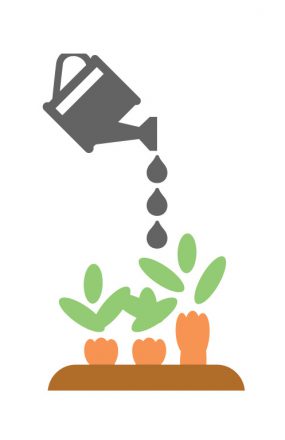
School Gardens
School garden programs can increase students’ nutrition knowledge, willingness to try fruit and vegetables, and positive attitudes about fruits and vegetables. 18-22 School gardens vary in size and purpose. Schools may have window sill gardens, raised beds, greenhouses, or planted fields.
Students can prepare the soil for the garden, plant seeds, harvest the fruits and vegetables, and taste the food from the garden. Produce from school gardens can be incorporated into school meals or taste tests. Classroom teachers can teach lessons in math, science, history, and language arts using the school garden.
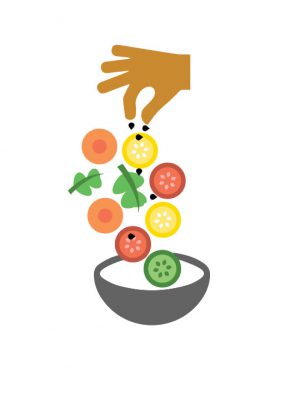
In the Cafeteria
Cafeterias are learning labs where students are exposed to new foods through the school meal program, see what balanced meals look like, and may be encouraged to try new foods through verbal prompts from school nutrition staff, 23 or taste tests. 24-25 Cafeterias may also be decorated with nutrition promotion posters or student artwork promoting healthy eating. 24
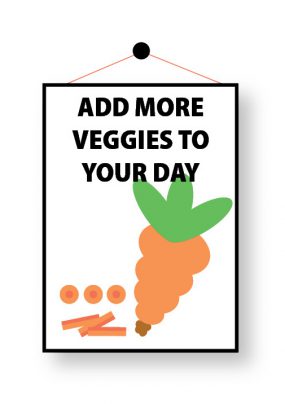
Other Opportunities
Schools can add messages about nutrition and healthy eating into the following:
- Morning announcements.
- School assemblies.
- Materials sent home to parents and guardians. 24
- Staff meetings.
- Parent-teacher group meetings.
These strategies can help reinforce messages about good nutrition and help ensure that students see and hear consistent information about healthy eating across the school campus and at home. 2
Shared use agreements can extend healthy eating learning opportunities. As an example, an after-school STEM club could gain access to school gardens as learning labs.
CDC Parents for Healthy Schools: Ideas for Parents
Nutrition: Gardening Interventions | The Community Guide
Dietary Guidelines for Americans, 2020–2025
Introduction to School Gardens
Learning Through the Garden
National Farm-to-School Network
National Farm to School Network Resource Database
National Health Education Standards
Team Nutrition Curricula
USDA Farm to School
USDA Team Nutrition
- Centers for Disease Control and Prevention. School health guidelines to promote healthy eating and physical activity. MMWR Morb Mortal Wkly Rep . 2011;60(RR-5):1–76.
- Joint Committee on National Health Education Standards. National Health Education Standards: Achieving Excellence. 2nd ed. Atlanta, GA: American Cancer Society; 2007.
- Centers for Disease Control and Prevention. Health Education Curriculum Analysis Tool, 2012, Atlanta, GA: Centers for Disease Control and Prevention, US Department of Health and Human Services; 2012. Available at http://www.cdc.gov/healthyyouth/hecat/index.htm. Accessed April 9, 2019.
- Price C, Cohen D, Pribis P, Cerami J. Nutrition education and body mass index in grades K–12: a systematic review. J Sch Health. 2017;87:715–720.
- Meiklejohn S, Ryan L, Palermo C. A systematic review of the impact of multi-strategy nutrition education programs on health and nutrition of adolescents. J Nutr Educ Behav . 2016;48:631–646.
- Silveira JA, Taddei JA, Guerra PH, Nobre MR. The effect of participation in school-based nutrition education interventions on body mass index: A meta-analysis of randomized controlled community trials. Prev Med . 2013;56:237–243.
- County Health Rankings and Roadmaps. School-based Nutrition Education Programs website. http://www.countyhealthrankings.org/take-action-to-improve-health/what-works-for-health/policies/school-based-nutrition-education-programs . Accessed on April 9, 2019.
- Results from the School Health Policies and Practices Study 2014 . Atlanta, GA: Centers for Disease Control and Prevention; 2014.
- Connell DB, Turner RR, Mason EF. Results of the school health education evaluation: health promotion effectiveness, implementation, and costs . J Sch Health . 1985;55(8):316–321.
- Institute of Medicine. Nutrition Education in the K–12 Curriculum: The Role of National Standards: Workshop Summary. Washington, DC: The National Academies Press; 2014.
- Murimi MW, Moyeda-Carabaza AF, Nguyen B, Saha S, Amin R, Njike V. Factors that contribute to effective nutrition education interventions in children: a systematic review. Nutr Rev . 2018;76(8):553–580.
- Hayes D, Contento IR, Weekly C. Position of the American Dietetic Association, School Nutrition Association, and Society for Nutrition Education: comprehensive school nutrition services. J Acad Nutr Diet . 2018; 118:913–919.
- Joshi A, Misako Azuma A, Feenstra G. Do farm-to-school programs make a difference? Findings and future research needs . J Hunger Environ Nutr . 2008;3:229–246.
- Moss A, Smith S, Null D, Long Roth S, Tragoudas U. Farm to school and nutrition education: Positively affecting elementary school-aged children’s nutrition knowledge and consumption behavior. Child Obes . 2013;9(1):51–6.
- Bontrager Yoder AB, Liebhart JL, McCarty DJ, Meinen A, Schoeller D, Vargas C, LaRowe T. Farm to elementary school programming increases access to fruits and vegetables and increases their consumption among those with low intake . J Nutr Educ Behav . 2014;46(5):341–9.
- The National Farm to School Network. The Benefits of Farm to School website. http://www.farmtoschool.org/Resources/BenefitsFactSheet.pdf . Accessed on June 14, 2019.
- Berezowitz CK, Bontrager Yoder AB, Schoeller DA. School gardens enhance academic performance and dietary outcomes in children. J Sch Health . 2015;85:508–518.
- Davis JN, Spaniol MR, Somerset S. Sustenance and sustainability: maximizing the impact of school gardens on health outcomes. Public Health Nutr . 2014;18(13):2358–2367.
- Langellotto GA, Gupta A. Gardening increases vegetable consumption in school-aged children: A meta-analytical synthesis. Horttechnology . 2012;22(4):430–445.
- Community Preventative Services Task Force. Nutrition: Gardening Interventions to Increase Fruit and Vegetable Consumption Among Children. Finding and Rationale Statement .. https://www.thecommunityguide.org/sites/default/files/assets/Nutrition-Gardening-Fruit-Vegetable-Consumption-Children-508.pdf . Accessed on May 16, 2019.
- Savoie-Roskos MR, Wengreen H, Durward C. Increasing Fruit and Vegetable Intake among Children and Youth through Gardening-Based Interventions: A Systematic Review. Journal of the Academy of Nutrition and Dietetics 2017;11(2):240–50.
- Schwartz M. The influence of a verbal prompt on school lunch fruit consumption: a pilot study. Int J Behav Nutr Phys Act. 2007;4:6.
- Fulkerson JA, French SA, Story M, Nelson H, Hannan PJ. Promotions to increase lower-fat food choices among students in secondary schools: description and outcomes of TACOS (Trying Alternative Cafeteria Options in Schools). Public Health Nutr. 2003 ;7(5):665–674.
- Action for Healthy Kids. Tips for Hosting a Successful Taste Test website. http://www.actionforhealthykids.org/tools-for-schools/find-challenges/classroom-challenges/701-tips-for-hosting-a-successful-taste-test . Accessed on May 19, 2019.

Healthy Youth
To receive email updates about this page, enter your email address:

Exit Notification / Disclaimer Policy
- The Centers for Disease Control and Prevention (CDC) cannot attest to the accuracy of a non-federal website.
- Linking to a non-federal website does not constitute an endorsement by CDC or any of its employees of the sponsors or the information and products presented on the website.
- You will be subject to the destination website's privacy policy when you follow the link.
- CDC is not responsible for Section 508 compliance (accessibility) on other federal or private website.

An official website of the United States government
Here's how you know
The .gov means it’s official. Federal government websites often end in .gov or .mil. Before sharing sensitive information, make sure you’re on a federal government site.
The site is secure. The https:// ensures that you are connecting to the official website and that any information you provide is encrypted and transmitted securely.
About Grants
The lifecycle of grants and cooperative agreements consists of four phases: Pre-Award, Award, Post-Award, and Close Out.
Access to Data
The National Institute of Food and Agriculture is committed to serving its stakeholders, Congress, and the public by using new technologies to advance greater openness.
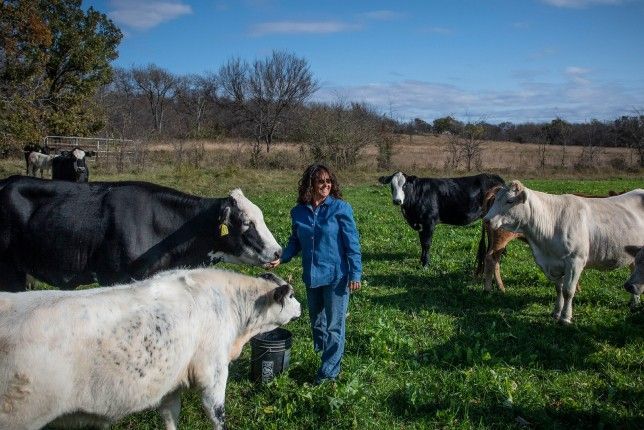
Access Data Gateway
The Data Gateway enables users to find funding data, metrics, and information about research, education, and extension projects that have received grant awards from NIFA.
View Resources Page
This website houses a large volume of supporting materials. In this section, you can search the wide range of documents, videos, and other resources.

Featured Webinar
Second annual virtual grants support technical assistance workshop.
Check out this five-day workshop in March 2024 workshop, designed to help you learn about NIFA grants and resources for grants development and management.
The National Institute of Food and Agriculture provides leadership and funding for programs that advance agriculture-related sciences.

Nutrition Education
For more than a half century, the United States Department of Agriculture (USDA) – “the People’s Department” – has funded nutrition education designed to improve safe food handling and preparation as well as the nutritional health and well-being of the population. In addition to providing general guidance through resources such as MyPlate and the Dietary Guidelines for Americans , USDA provides more specific nutrition education through programs for historically underserved populations. USDA also funds research to increase understanding of healthful food and beverage choices and to refine and improve educational content, methodologies, and evaluation metrics.
Importance of Nutrition Education
Nutrition education has been described as any combination of educational strategies, accompanied by environmental supports, designed to motivate, and facilitate voluntary adoption of food choices and other food- and nutrition-related behaviors conducive to health and well-being. Nutrition education is delivered through multiple venues and involves activities at the individual, community, and policy levels. Nutrition education also addresses critical issues such as food and nutrition security, food scarcity, food literacy, and food sustainability (Isobel Contento and Pamela Koch ( Nutrition Education: Linking Research, Theory, and Practice, Fourth Edition (2020)). From social ecological lens , effective nutrition education draws upon the collective strengths and contributions of individuals, families, communities, organizations, and other sectors of society to have its greatest potential to change eating behaviors, as well as advance health equity and well-being.
NIFA’s Impact
NIFA’s role in delivering high-quality nutrition education is a part of USDA’s four-pillar approach to Tackle Food and Nutrition Insecurity , one of the department’s current core priorities. In addition, NIFA’s contributions to improving nutrition education and the nutrition education workforce is highlighted in the historic White House Conference on Hunger, Nutrition, and Health and corresponding National Strategy , both of which aim to end hunger, improve nutrition and physical activity, and reduce diet-related diseases and disparities.
NIFA’s nutrition education program and research efforts are grounded in the Dietary Guidelines for Americans , Physical Activity Guidelines for Americans , and other federal food and nutrition guidelines and priorities. NIFA-funded programs are content and relationship-based, learner-centered, culturally relevant, and dynamic. Respect for lived experience is a core value of NIFA’s nutrition education programs. This is demonstrated by the vital role of peer educators and adaptation of content and methods to embrace differences in foods, learning styles, eating practices, languages, and family and community dynamics of those participating. Attention is also given to food costs, and to the shopping, preparation, safety, and storage of foods.
Evaluation is critical to the success of NIFA’s nutrition education portfolio. Evaluation of processes, progress, and outcomes allow participants and programs to recognize and celebrate success, identify gaps and barriers, raise research questions, and guide future program directions. The most recent EFNEP Impacts Report indicates the program reaches more than a half a million adults and families and more than 90% of adult EFNEP participants report improvement in what they eat each year. Similarly, the most recent GusNIP Year 3 Impacts Report demonstrated positive changes on participants’ fruit and vegetable intake and food security.
NIFA works closely with the Cooperative Extension System, other program partners, and grantees to ensure that nutrition education programming and the science that supports it leads to improved food and nutrition behaviors for improved health outcomes.
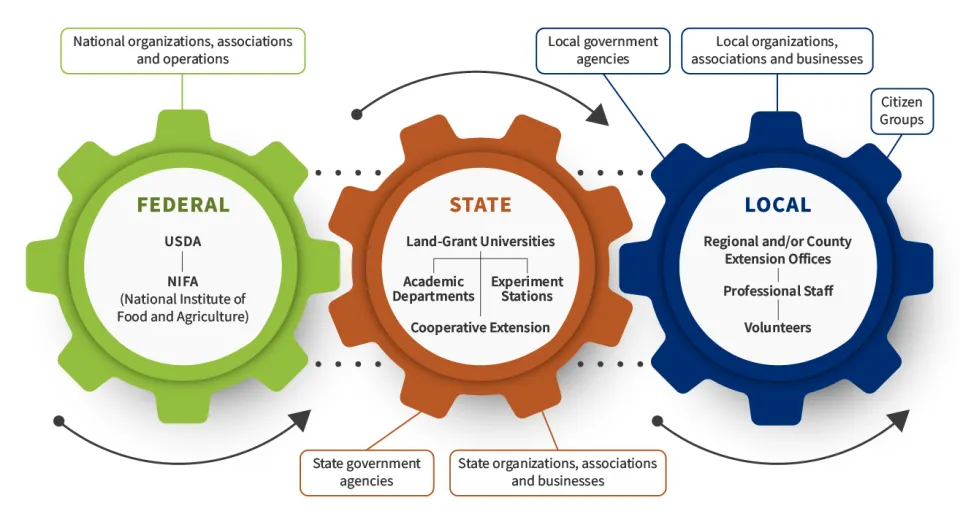
In addition, NIFA coordinates with other federal, tribal, state, and local agencies in addition to a variety of organizations including professional societies and non-profit organizations to facilitate improved nutritional health and well-being across different sectors of society. Examples include but are not limited to:
- Other federal nutrition assistance and education programs, such as the Food and Nutrition Service’s (FNS’) SNAP-Ed , WIC, and Team Nutrition programs, and
- Federal initiatives such as FDA’s Closer to Zero , FNS’ WIC Modernization , and the REE-led ASCEND initiative.
NIFA also participates in the following federal coordinating committees, among others:
- The USDA Nutrition Promotion Work Group,
- The USDA/HHS Dietary Guidelines Review Committee, and
- The Interagency Committee on Human Nutrition Research .
Key NIFA nutrition education relevant programs include:
- Expanded Food and Nutrition Education Program (EFNEP) : Is the nation’s first nutrition education program. Supports families with young children and youth living below the federal poverty line and remains at the forefront of nutrition education efforts to address food and nutrition security.
- Gus Schumacher Nutrition Incentive Program (GusNIP) : Supports the research and evaluation of projects providing incentives to increase the purchase or procurement of more fruits and vegetables by income-eligible consumers.
- Community Food Projects : Supports community-led food projects including urban agriculture.
- Food and Agriculture Service Learning Program (FASLP) : Supports projects that aim to increase the knowledge of agriculture and connect schools, communities, students, and farmers to improve the nutritional health of children.
- Agricultural and Food Research Initiative (AFRI) competitive grants program A1343 Food and Human Health : Supports investigations of the nutrients and contaminants in food and their impact on the gut microbiota.
- Agricultural and Food Research Initiative (AFRI) competitive grants program A1344 Diet, Nutrition, and the Prevention of Chronic Diseases : Supports projects that aim to improve food security and nutritional health outcomes for individuals and families through nutrition education approaches that include but are not limited to motivating or facilitating voluntary adoption of food and beverage choices, as well as other food and nutrition-related behaviors conducive to lifelong health and well-being.
- NIFA and FNS WIC National Workforce Strategy Development : Aims to strengthen the diversity and cultural competency of the WIC workforce.
Consumer Resources – USA.gov Government Benefits explains how to apply for and find social support programs, including nutrition assistance. Nutrition.gov is a USDA sponsored website that offers credible information to help you make healthful eating choices.
Nutrition Professional Resources – The USDA National Agricultural Library’s Food and Nutrition Information Center provides access to a range of resources from both government and non-government sources.
Your feedback is important to us.
- Skip to main content
- Skip to FDA Search
- Skip to in this section menu
- Skip to footer links

The .gov means it’s official. Federal government websites often end in .gov or .mil. Before sharing sensitive information, make sure you're on a federal government site.
The site is secure. The https:// ensures that you are connecting to the official website and that any information you provide is encrypted and transmitted securely.
U.S. Food and Drug Administration
- Search
- Menu
- Food Labeling & Nutrition
- Nutrition Education Resources & Materials
Health Educator’s Nutrition Toolkit: Setting the Table for Healthy Eating

En Español (Spanish)
The Health Educator’s Nutrition Toolkit is designed to help health educators, dietitians, physicians, other health care and nutrition professionals, social workers, youth counselors, and program directors teach consumers about the Nutrition Facts label and how to use the information it provides to make healthier food choices. The Toolkit offers a wide range of resources, including realistic tips on how to shop for and prepare food as well as order food when eating out to build a healthy diet.
The Toolkit includes:
- An introductory guide with information on how to use the toolkit (for health educators) (PDF - 1MB)
- Tip Sheet #1: Tips for Making Healthy Choices While Food Shopping (PDF - 15545KB)
- Tip Sheet #2: Tips for Bringing Nutrition into Your Home (PDF - 545KB)
- Tip Sheet #3: Tips for Making Healthy Choices When Eating Out (PDF - 409KB)
- Tip Card: Quick Tips for Reading the Nutrition Facts label (PDF - 273KB)
- A PowerPoint presentation, including notes, split into two sections – “Understanding the Nutrition Facts label” and “Bringing Nutrition Into Your Daily Life” (PPT - 43.4MB)
- Evaluation tools: a pre-test (DOC - 75KB) / post-test (DOC - 76KB) (10-15 questions) to accompany the PowerPoint presentation
- An infographic with tips on using the Nutrition Facts label and MyPlate when planning, shopping, cooking, and eating (PDF - 823KB)
Sample social media posts with nutrition education messages and graphics
Share the social media messages and graphics below to encourage your audience to make healthier choices at home and while dining out.
Sample Posts

DYK Americans eat and drink about one-third of their calories away from home? Use these tips from @FDAFood to make healthier food and beverage choices while dining out. www.fda.gov/media/131159/download
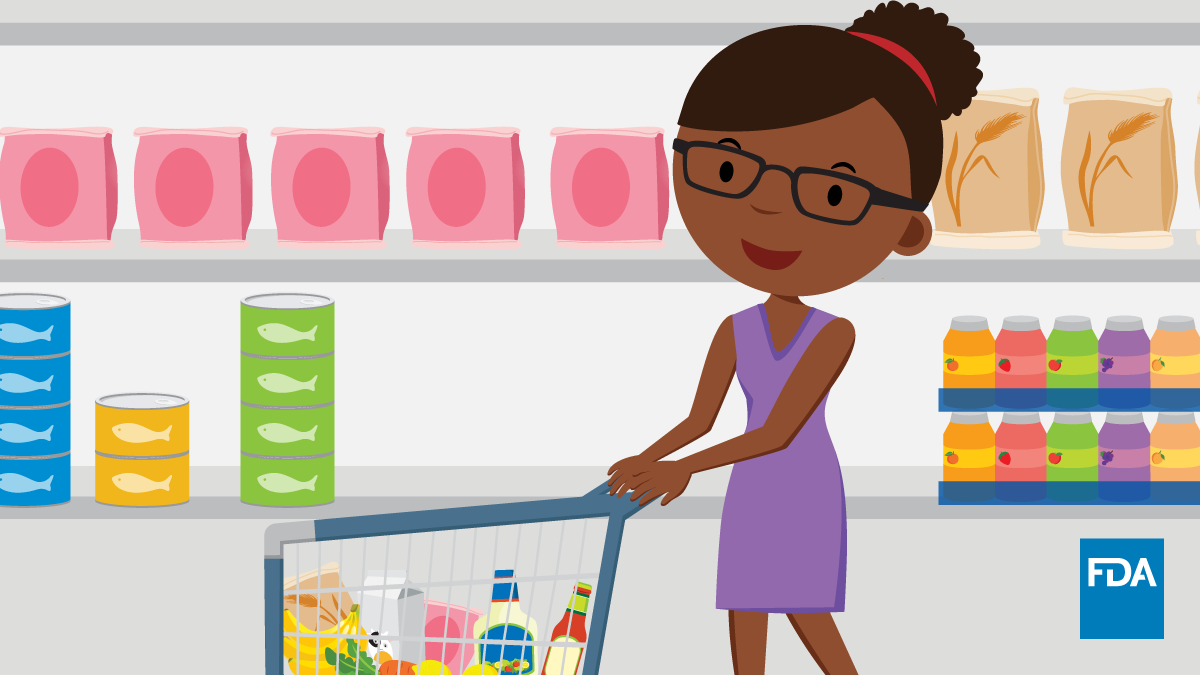
Healthy cooking and eating starts at the grocery store. Make healthy food purchases by reading the Nutrition Facts label. Here’s what to look for: www.fda.gov/media/131160/download .

Even small shifts to healthier food options can add up to healthy lifelong changes. Learn how: www.fda.gov/media/131191/download .

Commit to healthier choices at home and while dining out. Here are some tips from @FDAFood to help! www.fda.gov/media/131159/download .
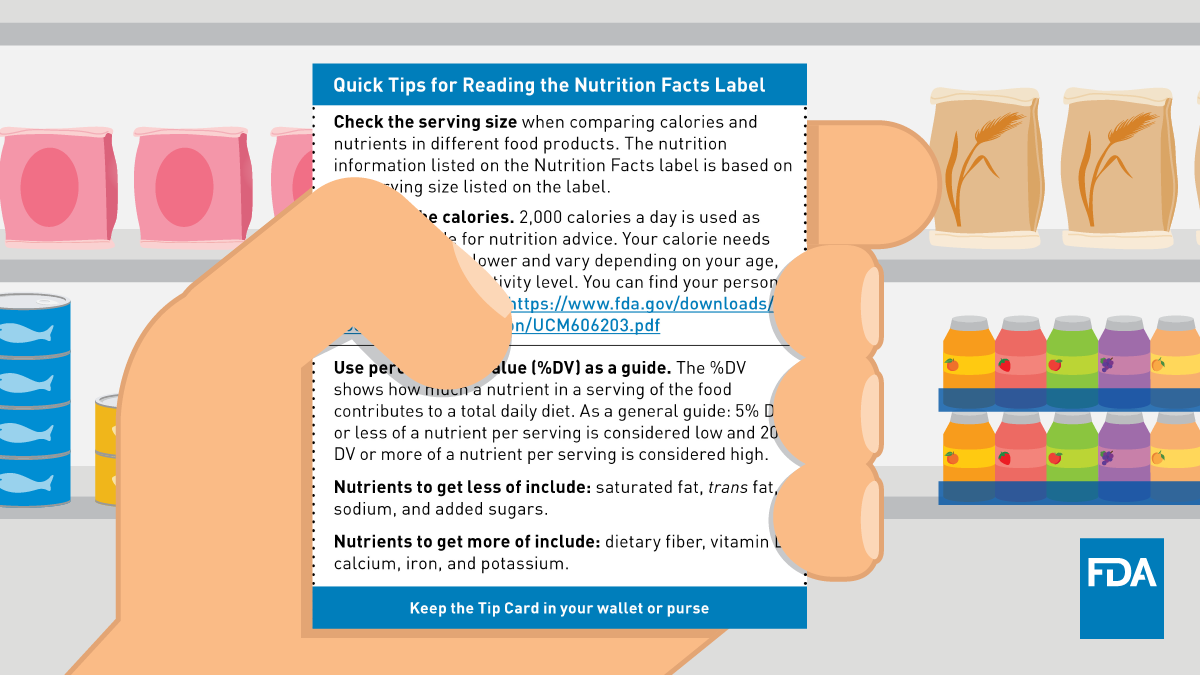
Is grocery shopping on your to-do list? Bring @FDAFood’s Tip Card with you to help you make healthy choices www.fda.gov/media/131162/download .
Sample Facebook Posts

Looking up nutrition information BEFORE you dine out can help you make healthier choices away from home. Check restaurant websites, phone apps, and menus. Once you have the nutrition information, choose items lower in calories, saturated fat, trans fat, sodium, and added sugars. www.fda.gov/media/131159/download .
Did you know Americans eat and drink about one-third of their calories away from home? Use these 3 tips to help you make healthier choices while dining out: www.fda.gov/media/131159/download .
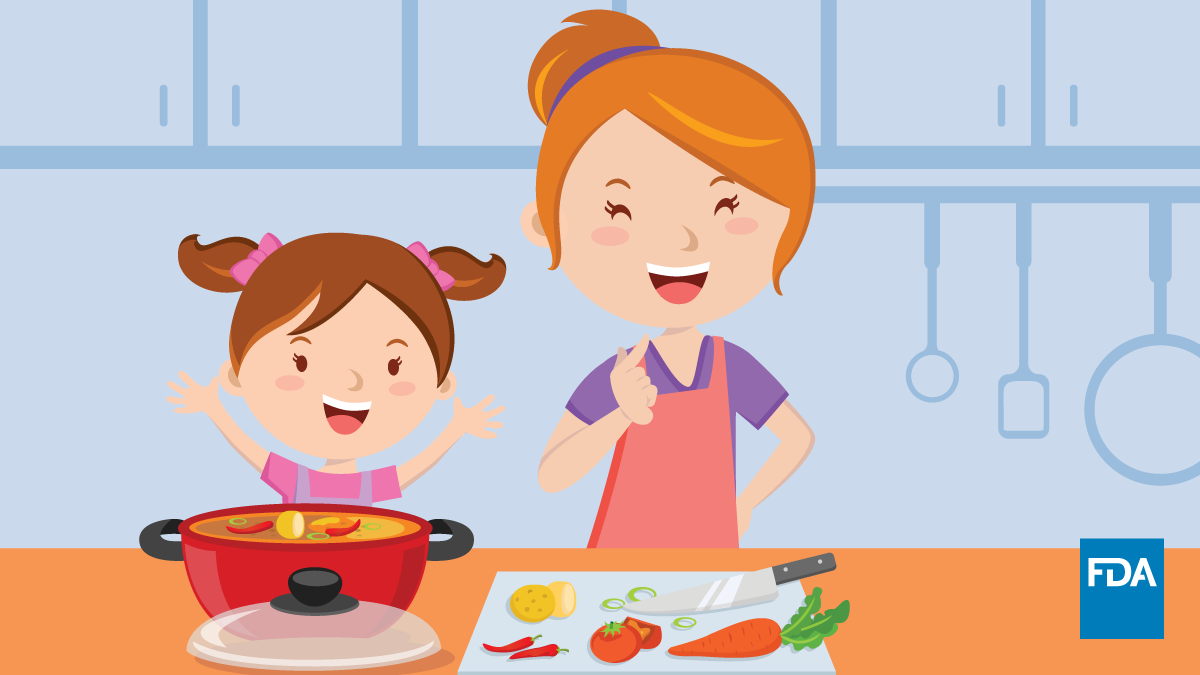
Commit to healthier choices at home and while dining out. These easy tips from FDA’s Nutrition Toolkit can get you started: www.fda.gov/media/131159/download and www.fda.gov/media/131160/download .
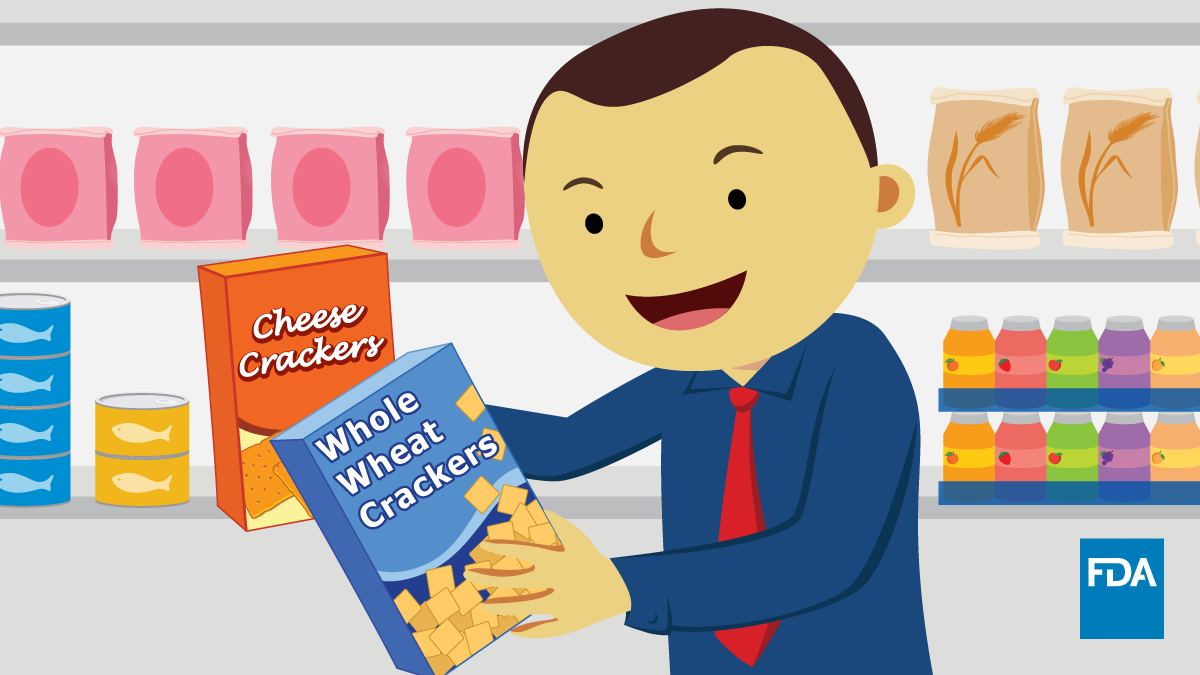
Take time to choose healthy options, whether you are food shopping, cooking or eating out. Even small shifts to healthier options can add up to healthy lifelong changes. www.fda.gov/media/131160/download .

Shop smart! Read the Nutrition Facts label when food shopping to make healthier choices for you and your family. www.fda.gov/media/131160/download .
Looking for more? Share one of our social media messages at @FDAFood on X , U.S. Food and Drug Administration on Facebook and Pinterest .
FDA has additional Nutrition Education Resources and Materials for a variety of audiences, which can be used along with the Toolkit for planning and conducting nutrition education programs and individual instruction.
High School Curriculum
An entirely digital experience with interactive components, these online lessons can be used anywhere and at anytime ... for free!
Grade Appropriate Nutrition Resources (9–12th Grades)
Emphasize nutrition holistically through online education and take-home resources.
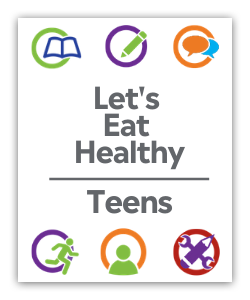
Let's Eat Healthy for Teens: Educator Guide Tutorial
This tutorial provides an overview of the step-by-step instruction in the educator’s guide.
Let’s Eat Healthy for Teens: Assign Content Online
Learn how to teach the Let’s Eat Healthy for Teens nutrition lesson series through Google Classroom.
Get started teaching nutrition education with monthly themes.
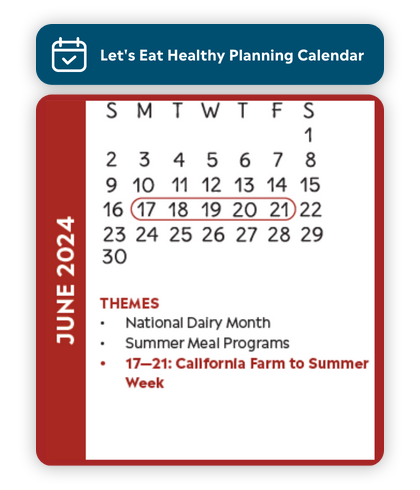
Use quizzes to complement lessons or use as a standalone.
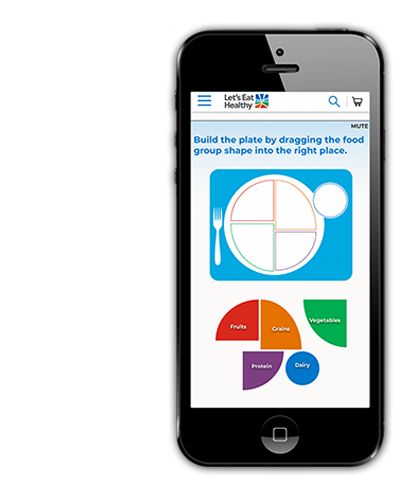
Nutrition Basics 101
Explore the Nutrition Primer and lay a foundation for teaching nutrition education.
New Nutrition Advocate?
Register a new account on HealthyEating.org to order nutrition resources, get the latest nutrition science or support healthy eating in your community.
Create account
Thanks for creating an account. Please login.
Forgot Password
Appointments at Mayo Clinic
- Nutrition and healthy eating
- Nutrition basics
- Healthy diets
- Healthy cooking
- Healthy menus and shopping strategies
- Nutritional supplements
Do you feel like you can't keep up with the latest nutrition news because it's always changing? It's true that knowledge about nutrition and diet evolves over time. But there are some nutrition basics that can help you sort through the latest research and advice.
Nutrition basics come down to eating wholesome foods that support your health.
Want to go beyond the basics? Talk to a healthcare professional, such as a dietitian. You can ask for diet advice that takes into account your health, lifestyle and food preferences.
There is a problem with information submitted for this request. Review/update the information highlighted below and resubmit the form.
From Mayo Clinic to your inbox
Sign up for free and stay up to date on research advancements, health tips, current health topics, and expertise on managing health. Click here for an email preview.
Error Email field is required
Error Include a valid email address
To provide you with the most relevant and helpful information, and understand which information is beneficial, we may combine your email and website usage information with other information we have about you. If you are a Mayo Clinic patient, this could include protected health information. If we combine this information with your protected health information, we will treat all of that information as protected health information and will only use or disclose that information as set forth in our notice of privacy practices. You may opt-out of email communications at any time by clicking on the unsubscribe link in the e-mail.
Thank you for subscribing!
You'll soon start receiving the latest Mayo Clinic health information you requested in your inbox.
Sorry something went wrong with your subscription
Please, try again in a couple of minutes
- 2020-2025 Dietary Guidelines for Americans. U.S. Department of Health and Human Services and U.S. Department of Agriculture. https://www.dietaryguidelines.gov. Accessed June 13, 2023.
- Zeratsky KA (expert opinion). Mayo Clinic. June 21, 2023.
- Hensrud DD, ed. Add 5 habits. In: The Mayo Clinic Diet. 3rd ed. Mayo Clinic Press; 2023.
- Dietary supplements: What you need to know. Office of Dietary Supplements. https://ods.od.nih.gov/factsheets/WYNTK-Consumer/ Accessed June 13, 2023.
- Vitamins, minerals and supplements: Do you need to take them? Academy of Nutrition and Dietetics. https://www.eatright.org/health/essential-nutrients/supplements/vitamins-minerals-and-supplements-do-you-need-to-take-them. Accessed June 22, 2023.
Products and Services
- Available Health Products from Mayo Clinic Store
- Nutritional Supplements at Mayo Clinic Store
- A Book: Cook Smart, Eat Well
- The Mayo Clinic Diet Online
- A Book: The Mayo Clinic Diet Bundle
- A Book: Mayo Clinic on High Blood Pressure
- A Book: Live Younger Longer
- Newsletter: Mayo Clinic Health Letter — Digital Edition
- A Book: Mayo Clinic Book of Home Remedies
- A Book: Mayo Clinic Family Health Book, 5th Edition
- A Book: Mayo Clinic on Digestive Health
- Health foods
- Antioxidants
- Alcohol use
- Alkaline water
- Artificial sweeteners and other sugar substitutes
- Autism spectrum disorder and digestive symptoms
- Breastfeeding nutrition: Tips for moms
- Butter vs. margarine
- Caffeine content
- Caffeine: How much is too much?
- Is caffeine dehydrating?
- Timing calcium supplements
- Calorie calculator
- COVID-19 and vitamin D
- Can vitamins help prevent a heart attack?
- Can whole-grain foods lower blood pressure?
- Can zinc supplements help treat hidradenitis suppurativa?
- Carbohydrates
- Chart of high-fiber foods
- Cholesterol: Top foods to improve your numbers
- Clear liquid diet
- Coconut water: Is it super hydrating?
- Coffee and health
- Cuts of beef
- DASH diet: Recommended servings
- Sample DASH menus
- Diet soda: How much is too much?
- Dietary fats
- Dietary fiber
- Diverticulitis attack triggers
- Diverticulitis diet
- Vitamin C and mood
- Prickly pear cactus
- Does soy really affect breast cancer risk?
- Don't get tricked by these 3 heart-health myths
- Eggs and cholesterol
- Enlarged prostate: Does diet play a role?
- Fasting diet: Can it improve my heart health?
- Fiber supplements
- Ground flaxseed
- Food safety
- Foodborne illness
- Gluten sensitivity and psoriasis: What's the connection?
- Gluten-free diet
- Gout diet: What's allowed, what's not
- Grass-fed beef
- Guide to herbs and spices
- Healthy meals start with planning
- Heartburn medicines and B-12 deficiency
- High-protein diets
- How to track saturated fat
- Intermittent fasting
- Is there a special diet for Crohn's disease?
- Low-fiber diet
- Low-glycemic index diet
- Meatless meals
- Mediterranean diet
- Menus for heart-healthy eating
- Moldy cheese
- Monosodium glutamate (MSG)
- Multivitamins for kids
- Nuts and your heart: Eating nuts for heart health
- Omega-3 in fish
- Omega-6 fatty acids
- Organic foods
- Phenylalanine
- Picnic Problems: High Sodium
- Portion control
- Prenatal vitamins
- Probiotics and prebiotics
- Safely reheat leftovers
- Sea salt vs. table salt
- Taurine in energy drinks
- Nutrition and pain
- Vitamin C megadoses
- Underweight: Add pounds healthfully
- Vegetarian diet
- Vitamin D and MS: Any connection?
- Vitamin D deficiency
- Can a lack of vitamin D cause high blood pressure?
- Vitamin D for babies
- Vitamin D toxicity
- Vitamins for MS: Do supplements make a difference?
- Water after meals
- Daily water requirement
- What is BPA?
- Whole grains
Mayo Clinic does not endorse companies or products. Advertising revenue supports our not-for-profit mission.
- Opportunities
Mayo Clinic Press
Check out these best-sellers and special offers on books and newsletters from Mayo Clinic Press .
- Mayo Clinic on Incontinence - Mayo Clinic Press Mayo Clinic on Incontinence
- The Essential Diabetes Book - Mayo Clinic Press The Essential Diabetes Book
- Mayo Clinic on Hearing and Balance - Mayo Clinic Press Mayo Clinic on Hearing and Balance
- FREE Mayo Clinic Diet Assessment - Mayo Clinic Press FREE Mayo Clinic Diet Assessment
- Mayo Clinic Health Letter - FREE book - Mayo Clinic Press Mayo Clinic Health Letter - FREE book
- Healthy Lifestyle
Your gift holds great power – donate today!
Make your tax-deductible gift and be a part of the cutting-edge research and care that's changing medicine.

Featured Products
Top 12 hot nutrition education topics.
Are you looking for a hot topic for your next class, workshop, or client consultation? Or for Nutrition Month (R)?
As much as consumers want a magic bullet for their health, teachers want a magic topic that will engage, educate, and motivate their audience . Here we have assembled all of the best and hottest topic predictions for 2023 . With nutrition there is always plenty of lessons to help people learn anything from the basics, to skipping fads, to shopping and preparing meals with ease, or to making better choices when dining out!
The hottest topics listed here are chosen from our expert writers’ recommendations, research in the news, views from our blog posts, many telephone and email inquiries with customers and readers, Amazon bestseller book lists, and over 100 food, health, and nutrition professional blogs that we follow.
Here are the hot topics and trends that you can use to plan your own presentations and classes.
- Dietary Guidelines : The Dietary Guidelines are here! Check out all of our resources that support the 2020-2025 messages. Many practitioners are focusing on nutrient density and the avoidance of ultra-processed foods. The Dietary Guidelines focus on getting the nutrients needed in the calories allotted based on age and activity levels. New this year are recommendations for children in specific age groups.
- New Food Label : The new Nutrition Facts Label is ready to empower shoppers to lower their intake of added sugars. Check out the newest food label resources .
- MyPlate On A Budget is very timely since most folks are pinching pennies with the current inflation bringing food costs up by about 7% – see the new app at MyPlate .
- Plant-Based Diets : Plant-based food sales are a hot topic, and sales are steadily growing, according to Statista. Focus on a plant slant ! How to Plan Meals, New Foods, Benefits.
- Sugar : How to Find It, How to Consume Less now that added sugars are featured on the new food label and still mentioned in the latest edition of the Dietary Guidelines, particularly for the younger set and adults. Our clients are always looking to teach people to drink fewer sugar calories.
- Fiber is a great lesson for consumers to understand gut health, plus all of the new research about the microbiome.
- Kitchen How-To – Americans are still cooking at home after the pandemic, so they are open to learning about new foods and cooking methods to save time. There is no better time for cooking demos, social media tips, and more!
- Weight Loss – Over 65% of all adults are overweight or obese, according to CDC. A CDC survey found that half of all adults over the age of 20 have tried to lose weight over the past year, but two-thirds of all adults in the US are still overweight or obese. Check out our 12 Lessons Program ! The pandemic showed us the importance of avoiding chronic diseases like obesity, heart disease, and type 2 diabetes, all of which can cause severe illness and death in COVID patients.
- Sleep – for better habits and weight loss success – a new study shows how and there are numerous studies on sleep and weight control. Sleep is an important part of any healthy eating plan.
- Diet is more important than exercise – Diet is more important than ever to help people keep BMI, blood pressure, and cholesterol low. Check out our new poster; You Can’t Outrun Your Fork!
- High blood pressure is a concern. We get more searches on low-sodium shopping lists than any other topic. Furthermore, diet is an excellent strategy, with research showing the low-sodium DASH diet as the most effective approach. This can bring many great teaching opportunities for health professionals.
- Prediabetes is an important educational topic. According to the CDC, diabetes is increasing at an alarming rate, with over 10% of the population diagnosed with this disease. This makes an excellent screening topic for health fairs.
All of these and more are in the new theme finder !
Check out the new products:
- New Product: Menu Planning Handouts
- Easy Health Fair and Nutrition Presentation Theme Chooser Introduced By Nutrition Education Store
- Breakfast Banners Developed for Dedicated Foodservice Director
- Health Fair Planning Guide
- Do You Have to Drink Green to Eat Clean?
Share this:
New products available now.
Check out the Nutrition Nuggets page which features over 20% off three special products each week.

Connect with us on Google Plus
Subscribe to our weekly editor's list
updated on 04-11-2024
Shipping and discount codes are added at checkout.
Want a daily email of lesson plans that span all subjects and age groups?
Subjects all subjects all subjects the arts all the arts visual arts performing arts value of the arts back business & economics all business & economics global economics macroeconomics microeconomics personal finance business back design, engineering & technology all design, engineering & technology design engineering technology back health all health growth & development medical conditions consumer health public health nutrition physical fitness emotional health sex education back literature & language all literature & language literature linguistics writing/composition speaking back mathematics all mathematics algebra data analysis & probability geometry measurement numbers & operations back philosophy & religion all philosophy & religion philosophy religion back psychology all psychology history, approaches and methods biological bases of behavior consciousness, sensation and perception cognition and learning motivation and emotion developmental psychology personality psychological disorders and treatment social psychology back science & technology all science & technology earth and space science life sciences physical science environmental science nature of science back social studies all social studies anthropology area studies civics geography history media and journalism sociology back teaching & education all teaching & education education leadership education policy structure and function of schools teaching strategies back thinking & learning all thinking & learning attention and engagement memory critical thinking problem solving creativity collaboration information literacy organization and time management back, filter by none.
- Elementary/Primary
- Middle School/Lower Secondary
- High School/Upper Secondary
- College/University
- TED-Ed Animations
- TED Talk Lessons
- TED-Ed Best of Web
- Under 3 minutes
- Under 6 minutes
- Under 9 minutes
- Under 12 minutes
- Under 18 minutes
- Over 18 minutes
- Algerian Arabic
- Azerbaijani
- Cantonese (Hong Kong)
- Chinese (Hong Kong)
- Chinese (Singapore)
- Chinese (Taiwan)
- Chinese Simplified
- Chinese Traditional
- Chinese Traditional (Taiwan)
- Dutch (Belgium)
- Dutch (Netherlands)
- French (Canada)
- French (France)
- French (Switzerland)
- Kurdish (Central)
- Luxembourgish
- Persian (Afghanistan)
- Persian (Iran)
- Portuguese (Brazil)
- Portuguese (Portugal)
- Spanish (Argentina)
- Spanish (Latin America)
- Spanish (Mexico)
- Spanish (Spain)
- Spanish (United States)
- Western Frisian
sort by none
- Longest video
- Shortest video
- Most video views
- Least video views
- Most questions answered
- Least questions answered

Why is rice so popular?
Lesson duration 04:53
525,123 Views

What would happen if everyone stopped eating meat tomorrow?
Lesson duration 04:37
609,718 Views

Which is better for you: "Real" meat or "fake" meat?
Lesson duration 05:19
442,022 Views

Is it possible to lose weight fast?
Lesson duration 04:57
2,142,492 Views

What is MSG, and is it actually bad for you?
Lesson duration 05:29
3,678,680 Views

The infamous overpopulation bet: Simon vs. Ehrlich
Lesson duration 04:48
565,220 Views

How do steroids affect your muscles— and the rest of your body? - Anees Bahji
Lesson duration 05:49
3,576,800 Views

Which type of milk is best for you?
Lesson duration 05:26
5,093,064 Views

Can we create the "perfect" farm?
Lesson duration 07:10
1,989,999 Views

The surprising effects of pregnancy
Lesson duration 05:46
9,859,754 Views

Fruits and veggies for kids/Eat your rainbow
Lesson duration 03:30
25,554,939 Views

How racism makes us sick - David R. Williams
Lesson duration 17:28
308,795 Views

The 5 fabulous food groups
Lesson duration 04:32
2,334,523 Views

Why do we eat spoiled food?
Lesson duration 03:20
3,415,614 Views

The legend of Annapurna, Hindu goddess of nourishment
Lesson duration 05:09
3,703,353 Views

What happens to your body when you start exercising regularly
Lesson duration 04:19
9,099,424 Views


What would happen if you stopped brushing your teeth?
Lesson duration 02:58
1,430,840 Views

What causes heartburn?
Lesson duration 04:55
1,807,554 Views

Why does your voice change as you get older?
Lesson duration 05:06
1,709,758 Views

Myths you learned in health class
Lesson duration 05:03
531,703 Views

How do your hormones work?
Lesson duration 05:04
2,161,411 Views

What causes headaches?
Lesson duration 05:32
6,402,154 Views

How did teeth evolve?
Lesson duration 04:45
741,317 Views

What happens during a stroke?
Lesson duration 05:00
2,920,215 Views
Health and Nutrition Topics
Popular topics.
- abdominal aortic aneurysm
- abdominal fat
- abdominal pain
- Academy of Nutrition and Dietetics
- acaí berries
- acid/base balance
- adolescence
- adrenal gland
- advanced glycation end-products (AGEs)
- Adventist Health Studies
- African Americans
- Agent Orange
- air pollution
- Albert Einstein
- alfalfa sprouts
- alkaline diet
- alkaline water
- almond milk
- alternative medicine
- Alzheimer’s disease
- American College of Lifestyle Medicine
- American Diabetes Association
- American Egg Board
- American Heart Association
- American Medical Association
- anal health
- angiogenesis
- angioplasty
- animal products
- animal protein
- animal studies
- ankylosing spondylitis
- anthocyanins
- anti-inflammatory
- antibiotics
- antidepressants
- antihistamines
- antioxidant
- antioxidants
- antiperspirant
- aortic aneurysm
- aphthous ulcers
- appendicitis
- apple cider vinegar
- apple juice
- arachidonic acid
- aromatherapy
- artery function
- artificial colors
- artificial flavors
- artificial sweeteners
- atherosclerosis
- Atkins diet
- atrial fibrillation
- autoimmune diseases
- Ayurvedic medicine
- bacterial vaginosis
- baking soda
- Barrett's esophagus
- basal cell carcinoma
- bell peppers
- beta carotene
- beta glucan
- Bilophilia wadsworthia
- bipolar disorder
- birth control pills
- birth defects
- Black Americans
- black beans
- black cumin
- black raspberries
- blackberries
- bladder cancer
- bladder health
- bladder infections
- blood cancer
- blood clots
- blood donation
- blood pressure
- blood sugar
- blood type diet
- blue-green algae
- blueberries
- body weight
- bone cancer
- bone fractures
- bone health
- bone mineral density
- bovine leukemia virus
- bowel movements
- brain cancer
- brain health
- brain tumors
- brazil nuts
- breakfast cereal
- breast cancer
- breast cancer survival
- breast development
- breast health
- breast milk
- breast pain
- breastfeeding
- brewer's yeast
- broccoli sprouts
- brown rice syrup
- Brussels sprouts
- butternut squash
- button mushrooms
- C-reactive protein
- caloric restriction
- Campylobacter
- cancer survival
- canker sores
- caramel color
- carcinogens
- cardiovascular disease
- cardiovascular health
- carrageenan
- casomorphins
- cauliflower
- cayenne pepper
- celiac disease
- cell phones
- Center for Science in the Public Interest
- cervical cancer
- chamomile tea
- chanterelle mushrooms
- chemotherapy
- chewing gum
- chili peppers
- China Study
- CHIP program
- chlorophyll
- cholesterol
- chronic diseases
- chronic fatigue syndrome
- chronobiology
- climate change
- coconut milk
- coconut oil
- coconut water
- cod liver oil
- Coenzyme Q10
- collard greens
- colon cancer
- colon health
- colonoscopy
- colorectal cancer
- common cold
- complementary medicine
- constipation
- Consumers Union
- cooking methods
- coronavirus
- cost savings
- cranberries
- cranberry juice
- crimini mushrooms
- Crohn's disease
- cruciferous vegetables
- cultivated meat
- curry powder
- Daily Dozen
- Daniel Fast
- dark chocolate
- dehydration
- dental health
- detoxification
- dietary guidelines
- diverticulitis
- Dr. Ancel Keys
- Dr. Caldwell Esselstyn
- Dr. David Katz
- Dr. Dean Ornish
- Dr. Denis Burkitt
- Dr. Joel Fuhrman
- Dr. Joel Kahn
- Dr. John Harvey Kellogg
- Dr. John McDougall
- Dr. Kim Williams
- Dr. Linus Pauling
- Dr. Neal Barnard
- Dr. Roy Swank
- Dr. Steven Gundry
- Dr. T. Colin Campbell
- Dr. Walter Kempner
- Dr. Walter Willett
- dried fruit
- ear infections
- Earl Grey tea
- eating disorders
- endocrine disruptors
- endometrial cancer
- endometrial health
- endometriosis
- endothelium
- energy drinks
- environment
- epigenetic changes
- epigenetics
- erectile dysfunction
- ergothioneine
- esophageal cancer
- esophagus health
- essential tremor
- factory farming practices
- fatty liver disease
- fecal bacteria
- fecal contamination
- fecal transplant
- fecal transplants
- feed additives
- fennel seeds
- fermented foods
- fibrocystic breast disease
- fibromyalgia
- flexitarians
- food additives
- food poisoning
- foodborne illness
- Framingham Heart Study
- free radicals
- Freedom of Information Act
- french fries
- frozen fruit
- fruit juice
- gallbladder disease
- gallbladder health
- gastric bypass
- genital warts
- Gerson Therapy
- Global Burden of Disease Study
- glycemic index
- glycotoxins
- goji berries
- gooseberries
- grape juice
- Grave’s disease
- green beans
- Guillain-Barré syndrome
- hair health
- hand washing
- Harvard Nurses' Health Study
- HDL cholesterol
- health food stores
- heart disease
- heart failure
- heart health
- heavy metals
- hemorrhoids
- herbal remedies
- heterocyclic amines
- hiatal hernia
- hibiscus tea
- hidradenitis suppurativa
- high blood pressure
- high cholesterol
- high fructose corn syrup
- homocysteine
- hot flashes
- How Not to Age
- How Not to Die
- How Not to Diet
- human papilloma virus
- Huntington’s disease
- hydrogenated fats
- hypertension
- hysterectomy
- immune function
- incontinence
- industrial pollutants
- industry influence
- infant formula
- infertility
- inflammation
- inflammatory bowel disease
- insulin resistance
- Introductory Videos
- irritable bowel syndrome
- isoflavones
- joint health
- Juice Plus supplements
- kidney beans
- kidney cancer
- kidney disease
- kidney failure
- kidney function
- kidney health
- kidney stones
- kombucha tea
- lactic acid
- LDL cholesterol
- lemons balm
- lichen planus
- life expectancy
- lifestyle medicine
- liposuction
- lipotoxicity
- liquid smoke
- liver cancer
- liver disease
- liver health
- liver inflammation
- Lou Gehrig's disease
- low-carb diets
- low-fat diets
- lung cancer
- lung health
- Lyme disease
- macadamia nuts
- macrobiotic diet
- macular degeneration
- mad cow disease
- maple syrup
- meat substitutes
- Meatless Mondays
- medical education
- medical profession
- medications
- Mediterranean diet
- medium-chain fatty acids
- men's health
- menstruation
- mental health
- metabolic syndrome
- microwaving
- migraine headaches
- mindfulness
- miscarriage
- mitochondria
- morning sickness
- mosquito repellent
- multiple myeloma
- multiple sclerosis
- multivitamins
- muscle health
- muscle soreness
- muscle strength
- mustard greens
- mustard powder
- mustard seeds
- nail health
- nasal irrigation
- National Cancer Institute
- National Pork Board
- nerve health
- neurocysticercosis
- neurotoxins
- neutropenic diet
- nitric oxide
- nitrosamines
- non-Hodgkin lymphoma
- nonalcoholic fatty liver disease
- nutrient absorption
- nutrition myths
- nutritional yeast
- oil pulling
- Okinawan diet
- omega-3 fatty acids
- oral cancer
- orange juice
- organ meats
- organic foods
- osteoarthritis
- osteoporosis
- ovarian cancer
- ovary health
- oxidative stress
- oyster mushrooms
- paleolithic diets
- palmitic acid
- pancreas health
- pancreatic cancer
- pancreatitis
- paratuberculosis
- Parkinson's disease
- peanut butter
- penis cancer
- penis health
- peppermint oil
- periodontal disease
- peripheral artery disease
- persistent organic pollutants
- petroleum jelly
- phosphate additives
- Physicians Committee for Responsible Medicine
- phytic acid
- phytoestrogens
- phytonutrients
- phytosterols
- pickled vegetables
- pinto beans
- placebo effect
- plant protein
- Plant-Based Diets
- polycyclic aromatic hydrocarbons
- polyphenols
- pomegranate juice
- pomegranates
- poppy seeds
- portobello mushrooms
- potassium chloride
- potassium sorbate
- potato chips
- prediabetes
- premenstrual syndrome
- prenatal vitamins
- preservatives
- pressure cooking
- prion disease
- processed foods
- processed meat
- prostate cancer
- prostate health
- protein powder
- pumpkin seeds
- raspberries
- rectal cancer
- reductionism
- reproductive health
- resistant starch
- respiratory infections
- resveratrol
- retinopathy
- rheumatoid arthritis
- rooibos tea
- safety limits
- safflower oil
- saturated fat
- schizophrenia
- sea vegetables
- second meal effect
- sesame seeds
- sexual function
- sexual health
- shark cartilage
- shiitake mushrooms
- short-chain fatty acids
- side effects
- Sjögren’s syndrome
- skin cancer
- skin health
- sleeping pills
- smoking cigarettes
- sodium lauryl sulfate
- soybean oil
- sperm counts
- sports drinks
- sports medicine
- St. John's Wort
- standard American diet
- staph infection
- stearic acid
- stomach cancer
- stomach health
- stomach inflammation
- stomach ulcers
- strawberries
- sulforaphane
- sunflower oil
- sunflower seeds
- supplements
- sweet potatoes
- Sweet'N Low
- Swiss chard
- tanning beds
- tart cherries
- tea tree oil
- testicular cancer
- testicular health
- testosterone
- The Plant Paradox
- throat cancer
- throat health
- thyroid cancer
- thyroid health
- titanium dioxide
- tomato juice
- tomato sauce
- tongue scraping
- triglycerides
- type 1 diabetes
- ulcerative colitis
- urinary tract infections
- uterine cancer
- vaginal cancer
- vaginal health
- varicose veins
- vegetable oil
- vegetable protein
- vegetarians
- veggie burgers
- viral infections
- vitamin B12
- vitamin D supplements
- weight gain
- weight loss
- white blood cell count
- women's health
- workplace wellness
- World Health Organization
- wound healing
- xenoestrogens
- xenohormesis
- zoonotic disease
Pin It on Pinterest
Nutrition Topics
This page brings together all our content – articles, publications and videos – on each of the 10 key nutrition topics. You can select a topic to find the latest site content relating to that specialty, including links to other relevant journals and organizations that you may find interesting.
Sponsorship Disclosure: Many of the publications, programs, conferences, educational resources and other content available on this website have been funded and/or prepared by the Nestle Nutrition Institute or its Nestle affiliates.

Human Milk Oligosaccharides

Breastfeeding

Growth & Development

Gut Microbiota

Malnutrition

Low Birth Weight

Nutrition, Health and Wellness

Nutrition & Disease Management
Advertisement
Comment and Health
Why nutrition needs to be on the educational agenda.
Nutrition must be as essential as maths or science at our educational institutions to solve the US obesity crisis, says Aman Majmudar
By Aman Majmudar
10 April 2024

ADRIA VOLTA
March was National Nutrition Month in the US, the latest in a decades-long campaign to improve eating habits. This year’s theme was “ Beyond the Table “, highlighting how food gets from farms to markets to our plates, how we might store and treat food safely at home and how we can reduce food waste.
Though these are important topics, such education must happen more often if it is to help curb a worsening chronic illness crisis. Nearly half of US adults will be obese in 2030. Obesity increases the risk of over 200 other conditions, from arthritis to breast cancer.…
Sign up to our weekly newsletter
Receive a weekly dose of discovery in your inbox! We'll also keep you up to date with New Scientist events and special offers.
To continue reading, subscribe today with our introductory offers
No commitment, cancel anytime*
Offer ends 2nd of July 2024.
*Cancel anytime within 14 days of payment to receive a refund on unserved issues.
Inclusive of applicable taxes (VAT)
Existing subscribers
More from New Scientist
Explore the latest news, articles and features
Why you may have a stealth liver disease and what to do about it
Subscriber-only
Is anxiety rising in children and if so, why?
Hunger-inducing mutation makes some labradors more likely to get fat, 1 in 8 people worldwide has obesity, popular articles.
Trending New Scientist articles
Get the latest news and stories from Tufts delivered right to your inbox.
Most popular.
- Activism & Social Justice
- Animal Health & Medicine
- Arts & Humanities
- Business & Economics
- Campus Life
- Climate & Sustainability
- Food & Nutrition
- Global Affairs
- Points of View
- Politics & Voting
- Science & Technology
- Alzheimer’s Disease
- Artificial Intelligence
- Biomedical Science
- Cellular Agriculture
- Cognitive Science
- Computer Science
- Cybersecurity
- Entrepreneurship
- Farming & Agriculture
- Film & Media
- Health Care
- Heart Disease
- Humanitarian Aid
- Immigration
- Infectious Disease
- Life Science
- Lyme Disease
- Mental Health
- Neuroscience
- Oral Health
- Performing Arts
- Public Health
- University News
- Urban Planning
- Visual Arts
- Youth Voting
- Cummings School of Veterinary Medicine
- Friedman School of Nutrition Science and Policy
- The Fletcher School
- Graduate School of Arts and Sciences
- Graduate School of Biomedical Sciences
- Jean Mayer USDA Human Nutrition Research Center on Aging
- Jonathan M. Tisch College of Civic Life
- School of Arts and Sciences
- School of Dental Medicine
- School of Engineering
- School of Medicine
- School of the Museum of Fine Arts
- University College
- Australia & Oceania
- Canada, Mexico, & Caribbean
- Central & South America
- Middle East

“How can we help teens develop a healthy relationship with food and movement, and create preferences that will carry them forward?” asks Erin Hennessy, dean for research strategy and associate professor at the Friedman School of Nutrition Science and Policy at Tufts University, and director of the project ChildObesity180. Illustration: Silvia Stecher / Ikon Images
On Teens, Nutrition, and Exercise: How to Encourage Healthy Habits
Experts across Tufts outline the challenges for today’s teens when it comes to healthy eating and physical activity, and how parents and caregivers can help
Ask a teenager whether they’re eating healthy or getting enough exercise, and you might get a blank look.
With school getting more demanding, extracurricular activities multiplying, and college applications looming, teens have a lot going on. Many are also starting to work jobs, care for younger siblings, and take on other family duties–even amid drastic changes to their hormone levels and bodies, as well as their sense of who they are and their relationships with family and peers.

Dietitian Venus Kalami, N20
“It all comes together in a way that can be really wonderful, but also really overwhelming,” said Venus Kalami, N20, director of pediatric nutrition at the company Solid Starts, who has worked heavily with teens in her seven years of experience as a clinical dietitian.
Erin Hennessy , dean for research strategy and associate professor at the Friedman School of Nutrition Science and Policy at Tufts and director of the project ChildObesity180 , agreed. “In the order of things that teens have to be concerned about, nutrition and exercise are low,” she said.
But as a public health concern, they’re high on the list. Whether they know it or not, most teens are not meeting the Dietary Guidelines for Americans in major ways, according to Christina Economos , dean of the Friedman School and founder of ChildObesity180.

Christina Economos
They’re eating fewer fruits, vegetables, and whole grains, and more added sugars, saturated fat, and sodium than the guidelines advise. And only one in five adolescents are meeting the Center for Disease Control and Prevention’s guidelines for aerobic and muscle-strengthening activities (60 minutes of physical activity a day, 30 of them “vigorous”).
Due to demanding schedules and other factors, many teens find it difficult to eat regular meals and stay hydrated, Kalami said, which leads to lower energy levels and worse moods.
If not addressed, it can affect their health in the long run, too. Not building enough muscle and bone can lead to lower bone density in adulthood. Obesity in adolescence makes adult obesity almost 18 times more likely–and almost 30% of teens today have overweight or obesity, compared to 15% 60 years ago. On top of that, a record high 10% of U.S. households with children are food insecure, and rates of eating disorders among teens are on the rise. All this only got worse over the pandemic, with many parents out of work, teens stuck at home, and high levels of stress across the board.
But there are things that teens and the adults around them can do to promote healthier eating and more exercise, Tufts experts agreed–and there is reason for optimism, Hennessy added.

Erin Hennessy
“Over the past few decades as we’ve seen an increase in obesity rates, we have also seen a shift in interest among children, teens, and young adults who are becoming much more interested in food, food justice, agriculture, the environment, and how those pieces are interconnected,” Hennessy said. “They’re coming to us at the Friedman School with far more understanding and knowledge about the field than I’ve ever seen, and it’s great to see that kind of shift and personal engagement with those topics.”
Tips for vegetarian and vegan teens
- Contrary to popular belief, kids and teenagers can be vegetarians or vegans and still eat a healthy, complete diet that meets all their nutrient needs.
- Eating vegetarian or vegan does not automatically make for a healthy diet.
- Cow’s milk is not less healthy than plant-based milks, and can play an important role in a healthy diet if you’re vegetarian but not vegan.
- If you’re vegan, drink plant-based milks for calcium and vitamin D—particularly soy milk, which has high bioavailability of these nutrients.
- Eat high-protein plant-based foods, such as nuts, beans, and seeds—quinoa is a great high-protein alternative to rice or pasta. Read the ingredients before buying meat substitutes, which can be high in added sugars and sodium.
- Eat plant-based foods high in iron, such as beans and leafy greens. Try to consume vitamin C-rich foods (such as citrus fruits) at the same time to increase your iron absorption.
- If you’re vegetarian, consume eggs and dairy to meet your vitamin B12 needs. If you’re vegan, consume nutritional yeast or B12-fortified products such as plant-based milks or yogurts.
Source: Christina Economos, dean of the Friedman School of Nutrition Science and Policy
Challenges for Teen Nutrition and Exercise
As children become teens, their energy and nutrient needs shoot up to an all-time high, because their bodies are growing. Particularly important for this growth are protein (for new tissue of all kinds), calcium and vitamin D (for bones), and iron, especially for those who are beginning to menstruate.
At the same time, teens’ schedules are getting busier, and their sleeping hours are shifting, leading to more barriers with eating regular meals and instead, leaning more on snacking. They are eating less at home, where parents might offer a healthy menu, and more with their friends or on their own–which leads to more fast food, processed snacks, soda, and sports drinks, especially at high schools with nearby convenience stores. “There’s a whole system that pushes the production, distribution, access, marketing, and palatability of unhealthy processed and ultra-processed foods ,” Economos said.
Teens’ higher order executive functions such as impulse control and long-term thinking are still developing, making it tougher to make nutritious choices in a landscape already skewed toward unhealthy options. And with adolescence comes greater self-consciousness about one’s body and eating, more scrutiny and comparison on social media, and increasing levels of judgment from a society with unrealistic expectations about body size and weight–adding an extra level of stress, which drives emotional eating.
“There are growth spurts that cause their height and weight to shift in ways they haven’t experience before,” Hennessy said. “They can feel like their bodies are no longer in their control, which can cause stress and anxiety.”
More teenagers are also struggling with food allergies or intolerances, or medical conditions requiring dietary limitations–and the stress that comes along with them. “We can see a lot of over-restriction out of fear of accidentally ingesting something,” Kalami said. “And this may affect social life, hanging out with friends, participating in team sport events, and many domains of life.”
On the exercise side of things, Hennessy pointed out that research shows teens—particularly those who identify as girls—are less physically active than younger children. It helps to have access to team sports, exercise programs, or any physical activity opportunity and the support for engaging in these opportunities. But it also takes an environment—like having green space and neighborhoods safe to walk in—to also be physically active. Many teens from marginalized communities don’t have this type of access, she said.
And even parents’ most well-meaning efforts to improve teens’ eating and exercise can backfire. Studies show that an authoritarian parenting style, or one that’s high in control (lots of rules, restriction and controlling parental behaviors) and low in responsiveness (a lack of openness, warmth, support), is correlated with disordered eating symptoms in youths up to 18 years old, and high-risk behaviors such as substance abuse.
“Some younger adolescents are more comfortable with the rules and structure that their parents create and lay down,” Hennessy said, referring to the developmental psychology concept of the legitimacy of parental authority. “But older teens especially feel there are particular domain areas that their parents should not be making rules about, like who their friends are, or the ways they move their bodies, or what they ingest.” This can cause tension between parents and their teens.
Tips for teens with food allergies and intolerances
- Get the facts. If you suspect you have a food allergy or intolerance, visit an allergist for a blood test, skin prick test, or oral food challenge to determine what foods cause what reactions. If you were diagnosed a long time ago, visit an allergist again and see what treatment options may be available to you.
- Don’t unnecessarily cut out foods. Over-restriction can also be problematic. If you can comfortably consume a food without having difficulties, keep doing so. Try not to cut out foods you don’t have reactions to.
- With food allergies, take precautions . Read food labels and learn to properly interpret them. Ask about ingredients and cross-contamination potential at restaurants. Get an EpiPen prescription and always carry one in your purse or backpack, in addition to any other allergy medications; make sure your family or friends know how to administer it if you can’t (and what you’re allergic to).
Source: Dietitian Venus Kalami, N20
Tips to Promote Better Nutrition in Teens
In light of these many factors, what can parents do to supporting teens in nourishing their bodies and finding forms of exercise that make sense for them? Tufts experts offered guidance ranging from being aware of specific nutrients, to including teens in food-related decision-making in the family.
Margie Skeer , interim chair of the public health and community medicine department at Tufts University School of Medicine , advised having regular family meals. Besides being linked to higher fruit and vegetable consumption and lower rates of disordered eating among adolescents, family meals have a protective effect against other high-risk behaviors, such as substance abuse.
It’s also essential to recognize the many forces in play beyond individual choice, and to approach nutrition and exercise as not solely the teen’s problem, but a function of the overall health of the teen’s family and the broader environmental context in which the family is situated, Hennessy said.

Margie Skeer. Photo: Anna Miller
It’s essential to recognize the many forces in play beyond individual choice, and to approach nutrition and exercise as not the teen’s problem, but a function of the overall health of the teen’s family and environment, Hennessy said.
“How can we help teens develop a healthy relationship with food and movement, and create preferences that will carry them forward?” she asked. “How do we help create that foundation to return to throughout life for those who don’t have it, and how do we maintain it for those who do?”
Start with yourself. “How do I get my teen to go on a diet / exercise?” is a common online search phrase around teens and nutrition. But Hennessy suggested first stepping back and asking, “How am I role modeling healthy behaviors for my child?” and to shift the thinking from focusing on one child to thinking about the whole family and how the whole family can support and adopt healthy eating and movement behaviors.
Provide structure without being intrusive. Structure refers to the way parents organize their child’s environment to facilitate their child’s competence. What does that look like in practice? Setting rules and limits, providing limited or guiding choices, setting routines, role modeling, involving teens in food preparation and meal selection, and making healthy food available and accessible.
Know your teen’s nutritional needs. Consult a pediatrician or dietitian, Economos said, as well as resources such as the USDA’s MyPlate Nutrition Information for Teens . Pay special attention to whether your teen is getting enough dairy or plant-based dairy alternatives (for calcium and vitamin D), and iron sources such as red meat, beans, leafy greens, and fortified cereals.
Watch for changes and patterns. Rather than focusing on your teen’s size or weight, watch for new behaviors such as skipping meals, starting to eat much more or less, as well as higher stress levels around food, Hennessy said. Observe how often these behaviors repeat and provide support for your teen, and if there is ever a concern about certain behaviors, consult your healthcare provider.
Connect with your teen. Kalami has often asked about teenage clients’ passions and interests, which can provide the will and the ways to improve health. Skeer emphasized not just spending mealtimes with teens (ideally at least half of all meals), but making sure it’s quality time—meaning a relaxed, supportive environment with open communication and no distractions (such as phones). “Parents eating meals with teens conveys that spending time together is important to them,” Skeer said.
Empower your teen. Instead of prescribing healthy habits, learn your teen’s goals around eating–for example, being a vegetarian–and help them accomplish them in a healthy way, Hennessy said. Economos highlighted the importance of including kids in meal planning and preparation from a young age, teaching them culinary skills and healthy approaches to eating.
Look to local resources. Organizations like Girls on the Run can bring teenage girls together with supportive adults to walk, jog, and run in their neighborhoods, while local dance classes could introduce elements of culture and fun, Economos said. Teens can also get together to walk or train for a 5K, or take free online classes on yoga or strength training. “Goal setting as a group, and a structure where people care if you’re coming, can be really helpful,” Economos said.
Find one small change that works. Whether it’s swapping in nuts for potato chips, setting phone alarms to drink water, dancing to Zumba videos, or going to the park with a friend or family member, it’s the small, realistic changes that make a difference, Kalami said–and you can start with just one.
Support balance and variety. Encourage not just physical health, but overall “food-related quality of life,” said Kalami–especially among teens anxious about eating the wrong thing. “One of the main things I advocate for is minimizing unnecessary restriction, and loosening it up so we can get some flexibility, freedom, and variety back in our lives,” Kalami said.

Teen Behavior, Explained by a Neuroscientist

Advice for Parents and Caregivers on Teens and Mental Health

Got a Sleepy Teenager? Here’s What You Should Know
An official website of the United States government
Here’s how you know
Official websites use .gov A .gov website belongs to an official government organization in the United States.
Secure .gov websites use HTTPS A lock ( Lock Locked padlock icon ) or https:// means you’ve safely connected to the .gov website. Share sensitive information only on official, secure websites.
- Entire Site
- Research & Funding
- Health Information
- About NIDDK
- Diabetes Overview
Healthy Living with Diabetes
- Español
On this page:
How can I plan what to eat or drink when I have diabetes?
How can physical activity help manage my diabetes, what can i do to reach or maintain a healthy weight, should i quit smoking, how can i take care of my mental health, clinical trials for healthy living with diabetes.
Healthy living is a way to manage diabetes . To have a healthy lifestyle, take steps now to plan healthy meals and snacks, do physical activities, get enough sleep, and quit smoking or using tobacco products.
Healthy living may help keep your body’s blood pressure , cholesterol , and blood glucose level, also called blood sugar level, in the range your primary health care professional recommends. Your primary health care professional may be a doctor, a physician assistant, or a nurse practitioner. Healthy living may also help prevent or delay health problems from diabetes that can affect your heart, kidneys, eyes, brain, and other parts of your body.
Making lifestyle changes can be hard, but starting with small changes and building from there may benefit your health. You may want to get help from family, loved ones, friends, and other trusted people in your community. You can also get information from your health care professionals.
What you choose to eat, how much you eat, and when you eat are parts of a meal plan. Having healthy foods and drinks can help keep your blood glucose, blood pressure, and cholesterol levels in the ranges your health care professional recommends. If you have overweight or obesity, a healthy meal plan—along with regular physical activity, getting enough sleep, and other healthy behaviors—may help you reach and maintain a healthy weight. In some cases, health care professionals may also recommend diabetes medicines that may help you lose weight, or weight-loss surgery, also called metabolic and bariatric surgery.
Choose healthy foods and drinks
There is no right or wrong way to choose healthy foods and drinks that may help manage your diabetes. Healthy meal plans for people who have diabetes may include
- dairy or plant-based dairy products
- nonstarchy vegetables
- protein foods
- whole grains
Try to choose foods that include nutrients such as vitamins, calcium , fiber , and healthy fats . Also try to choose drinks with little or no added sugar , such as tap or bottled water, low-fat or non-fat milk, and unsweetened tea, coffee, or sparkling water.
Try to plan meals and snacks that have fewer
- foods high in saturated fat
- foods high in sodium, a mineral found in salt
- sugary foods , such as cookies and cakes, and sweet drinks, such as soda, juice, flavored coffee, and sports drinks
Your body turns carbohydrates , or carbs, from food into glucose, which can raise your blood glucose level. Some fruits, beans, and starchy vegetables—such as potatoes and corn—have more carbs than other foods. Keep carbs in mind when planning your meals.
You should also limit how much alcohol you drink. If you take insulin or certain diabetes medicines , drinking alcohol can make your blood glucose level drop too low, which is called hypoglycemia . If you do drink alcohol, be sure to eat food when you drink and remember to check your blood glucose level after drinking. Talk with your health care team about your alcohol-drinking habits.

Find the best times to eat or drink
Talk with your health care professional or health care team about when you should eat or drink. The best time to have meals and snacks may depend on
- what medicines you take for diabetes
- what your level of physical activity or your work schedule is
- whether you have other health conditions or diseases
Ask your health care team if you should eat before, during, or after physical activity. Some diabetes medicines, such as sulfonylureas or insulin, may make your blood glucose level drop too low during exercise or if you skip or delay a meal.
Plan how much to eat or drink
You may worry that having diabetes means giving up foods and drinks you enjoy. The good news is you can still have your favorite foods and drinks, but you might need to have them in smaller portions or enjoy them less often.
For people who have diabetes, carb counting and the plate method are two common ways to plan how much to eat or drink. Talk with your health care professional or health care team to find a method that works for you.
Carb counting
Carbohydrate counting , or carb counting, means planning and keeping track of the amount of carbs you eat and drink in each meal or snack. Not all people with diabetes need to count carbs. However, if you take insulin, counting carbs can help you know how much insulin to take.
Plate method
The plate method helps you control portion sizes without counting and measuring. This method divides a 9-inch plate into the following three sections to help you choose the types and amounts of foods to eat for each meal.
- Nonstarchy vegetables—such as leafy greens, peppers, carrots, or green beans—should make up half of your plate.
- Carb foods that are high in fiber—such as brown rice, whole grains, beans, or fruits—should make up one-quarter of your plate.
- Protein foods—such as lean meats, fish, dairy, or tofu or other soy products—should make up one quarter of your plate.
If you are not taking insulin, you may not need to count carbs when using the plate method.

Work with your health care team to create a meal plan that works for you. You may want to have a diabetes educator or a registered dietitian on your team. A registered dietitian can provide medical nutrition therapy , which includes counseling to help you create and follow a meal plan. Your health care team may be able to recommend other resources, such as a healthy lifestyle coach, to help you with making changes. Ask your health care team or your insurance company if your benefits include medical nutrition therapy or other diabetes care resources.
Talk with your health care professional before taking dietary supplements
There is no clear proof that specific foods, herbs, spices, or dietary supplements —such as vitamins or minerals—can help manage diabetes. Your health care professional may ask you to take vitamins or minerals if you can’t get enough from foods. Talk with your health care professional before you take any supplements, because some may cause side effects or affect how well your diabetes medicines work.
Research shows that regular physical activity helps people manage their diabetes and stay healthy. Benefits of physical activity may include
- lower blood glucose, blood pressure, and cholesterol levels
- better heart health
- healthier weight
- better mood and sleep
- better balance and memory
Talk with your health care professional before starting a new physical activity or changing how much physical activity you do. They may suggest types of activities based on your ability, schedule, meal plan, interests, and diabetes medicines. Your health care professional may also tell you the best times of day to be active or what to do if your blood glucose level goes out of the range recommended for you.

Do different types of physical activity
People with diabetes can be active, even if they take insulin or use technology such as insulin pumps .
Try to do different kinds of activities . While being more active may have more health benefits, any physical activity is better than none. Start slowly with activities you enjoy. You may be able to change your level of effort and try other activities over time. Having a friend or family member join you may help you stick to your routine.
The physical activities you do may need to be different if you are age 65 or older , are pregnant , or have a disability or health condition . Physical activities may also need to be different for children and teens . Ask your health care professional or health care team about activities that are safe for you.
Aerobic activities
Aerobic activities make you breathe harder and make your heart beat faster. You can try walking, dancing, wheelchair rolling, or swimming. Most adults should try to get at least 150 minutes of moderate-intensity physical activity each week. Aim to do 30 minutes a day on most days of the week. You don’t have to do all 30 minutes at one time. You can break up physical activity into small amounts during your day and still get the benefit. 1
Strength training or resistance training
Strength training or resistance training may make your muscles and bones stronger. You can try lifting weights or doing other exercises such as wall pushups or arm raises. Try to do this kind of training two times a week. 1
Balance and stretching activities
Balance and stretching activities may help you move better and have stronger muscles and bones. You may want to try standing on one leg or stretching your legs when sitting on the floor. Try to do these kinds of activities two or three times a week. 1
Some activities that need balance may be unsafe for people with nerve damage or vision problems caused by diabetes. Ask your health care professional or health care team about activities that are safe for you.

Stay safe during physical activity
Staying safe during physical activity is important. Here are some tips to keep in mind.
Drink liquids
Drinking liquids helps prevent dehydration , or the loss of too much water in your body. Drinking water is a way to stay hydrated. Sports drinks often have a lot of sugar and calories , and you don’t need them for most moderate physical activities.
Avoid low blood glucose
Check your blood glucose level before, during, and right after physical activity. Physical activity often lowers the level of glucose in your blood. Low blood glucose levels may last for hours or days after physical activity. You are most likely to have low blood glucose if you take insulin or some other diabetes medicines, such as sulfonylureas.
Ask your health care professional if you should take less insulin or eat carbs before, during, or after physical activity. Low blood glucose can be a serious medical emergency that must be treated right away. Take steps to protect yourself. You can learn how to treat low blood glucose , let other people know what to do if you need help, and use a medical alert bracelet.
Avoid high blood glucose and ketoacidosis
Taking less insulin before physical activity may help prevent low blood glucose, but it may also make you more likely to have high blood glucose. If your body does not have enough insulin, it can’t use glucose as a source of energy and will use fat instead. When your body uses fat for energy, your body makes chemicals called ketones .
High levels of ketones in your blood can lead to a condition called diabetic ketoacidosis (DKA) . DKA is a medical emergency that should be treated right away. DKA is most common in people with type 1 diabetes . Occasionally, DKA may affect people with type 2 diabetes who have lost their ability to produce insulin. Ask your health care professional how much insulin you should take before physical activity, whether you need to test your urine for ketones, and what level of ketones is dangerous for you.
Take care of your feet
People with diabetes may have problems with their feet because high blood glucose levels can damage blood vessels and nerves. To help prevent foot problems, wear comfortable and supportive shoes and take care of your feet before, during, and after physical activity.

If you have diabetes, managing your weight may bring you several health benefits. Ask your health care professional or health care team if you are at a healthy weight or if you should try to lose weight.
If you are an adult with overweight or obesity, work with your health care team to create a weight-loss plan. Losing 5% to 7% of your current weight may help you prevent or improve some health problems and manage your blood glucose, cholesterol, and blood pressure levels. 2 If you are worried about your child’s weight and they have diabetes, talk with their health care professional before your child starts a new weight-loss plan.
You may be able to reach and maintain a healthy weight by
- following a healthy meal plan
- consuming fewer calories
- being physically active
- getting 7 to 8 hours of sleep each night 3
If you have type 2 diabetes, your health care professional may recommend diabetes medicines that may help you lose weight.
Online tools such as the Body Weight Planner may help you create eating and physical activity plans. You may want to talk with your health care professional about other options for managing your weight, including joining a weight-loss program that can provide helpful information, support, and behavioral or lifestyle counseling. These options may have a cost, so make sure to check the details of the programs.
Your health care professional may recommend weight-loss surgery if you aren’t able to reach a healthy weight with meal planning, physical activity, and taking diabetes medicines that help with weight loss.
If you are pregnant , trying to lose weight may not be healthy. However, you should ask your health care professional whether it makes sense to monitor or limit your weight gain during pregnancy.
Both diabetes and smoking —including using tobacco products and e-cigarettes—cause your blood vessels to narrow. Both diabetes and smoking increase your risk of having a heart attack or stroke , nerve damage , kidney disease , eye disease , or amputation . Secondhand smoke can also affect the health of your family or others who live with you.
If you smoke or use other tobacco products, stop. Ask for help . You don’t have to do it alone.
Feeling stressed, sad, or angry can be common for people with diabetes. Managing diabetes or learning to cope with new information about your health can be hard. People with chronic illnesses such as diabetes may develop anxiety or other mental health conditions .
Learn healthy ways to lower your stress , and ask for help from your health care team or a mental health professional. While it may be uncomfortable to talk about your feelings, finding a health care professional whom you trust and want to talk with may help you
- lower your feelings of stress, depression, or anxiety
- manage problems sleeping or remembering things
- see how diabetes affects your family, school, work, or financial situation
Ask your health care team for mental health resources for people with diabetes.
Sleeping too much or too little may raise your blood glucose levels. Your sleep habits may also affect your mental health and vice versa. People with diabetes and overweight or obesity can also have other health conditions that affect sleep, such as sleep apnea , which can raise your blood pressure and risk of heart disease.

NIDDK conducts and supports clinical trials in many diseases and conditions, including diabetes. The trials look to find new ways to prevent, detect, or treat disease and improve quality of life.
What are clinical trials for healthy living with diabetes?
Clinical trials—and other types of clinical studies —are part of medical research and involve people like you. When you volunteer to take part in a clinical study, you help health care professionals and researchers learn more about disease and improve health care for people in the future.
Researchers are studying many aspects of healthy living for people with diabetes, such as
- how changing when you eat may affect body weight and metabolism
- how less access to healthy foods may affect diabetes management, other health problems, and risk of dying
- whether low-carbohydrate meal plans can help lower blood glucose levels
- which diabetes medicines are more likely to help people lose weight
Find out if clinical trials are right for you .
Watch a video of NIDDK Director Dr. Griffin P. Rodgers explaining the importance of participating in clinical trials.
What clinical trials for healthy living with diabetes are looking for participants?
You can view a filtered list of clinical studies on healthy living with diabetes that are federally funded, open, and recruiting at www.ClinicalTrials.gov . You can expand or narrow the list to include clinical studies from industry, universities, and individuals; however, the National Institutes of Health does not review these studies and cannot ensure they are safe for you. Always talk with your primary health care professional before you participate in a clinical study.
This content is provided as a service of the National Institute of Diabetes and Digestive and Kidney Diseases (NIDDK), part of the National Institutes of Health. NIDDK translates and disseminates research findings to increase knowledge and understanding about health and disease among patients, health professionals, and the public. Content produced by NIDDK is carefully reviewed by NIDDK scientists and other experts.
NIDDK would like to thank: Elizabeth M. Venditti, Ph.D., University of Pittsburgh School of Medicine.

Official websites use .gov A .gov website belongs to an official government organization in the United States.
Secure .gov websites use HTTPS A lock ( ) or https:// means you've safely connected to the .gov website. Share sensitive information only on official, secure websites.
Exercise and Fitness
Learn about the health benefits of physical activity, and find resources like exercise logs, planners, and examples to help you stay consistent over time.
View sample exercise routines and videos. Remember to start slow if you are new to exercise, and talk to your doctor if you have concerns.
Explore tools to help you with your physical activity goals, including exercise planners, logs and progress tests.
If you're thinking, "How can I meet the guidelines each week?" don't worry. You'll be surprised by the variety of activities you have to choose from.
Learn how to exercise safely when you have a chronic health condition, such as dementia, arthritis, or chronic pain.
Learn about the benefits of exercise and physical activity for older adults. Plus, find detailed information on how to get started, exercise safely, and stay on track.
Discover tips for becoming more active as an older adult, including how to get started and set fitness goals.
Looking to get back on track with your exercise routine? Check out these tips.
Find information on the benefits of physical activity, examples of moderate physical activity, and advice for beginners.
Learn about being active at any size while having fun and feeling good doing it.
Try these low or no-cost ideas for exercising without breaking the bank.
Provides information on physical activity and the body's use of calories as well as illustrations and definitions. Also in Spanish .
Find detailed information about the benefits of yoga for health and wellbeing.
View these fact sheets, posters, and videos for information on how to exercise safely during and after pregnancy.
The Physical Activity Guidelines for Americans provides evidence-based guidance to help Americans maintain or improve their health through physical activity.
Find advice on being active for individuals with disabilities.
Learn what women who are pregnant should know before and during exercise.
Find a list of physical activities you can do indoors.
Watch this video to understand the differences between low, moderate, and vigorous intensity exercise.
Get active without spending money or going to a gym. Here's how.
Learn how to plan and implement a mall walking program for your community.

IMAGES
VIDEO
COMMENTS
Explore reliable resources on food, nutrition, physical activity, and food safety to help you build healthy habits.
Discover resources and learn more about popular nutrition education topics. View Resources Page. Resources Submenu. Nutrition Education Materials; Seasonal Produce Guide; Recipes and Menus; ... SNAP-Ed nutrition education aligns with the Dietary Guidelines for Americans and MyPlate. Find materials that focus on healthy eating, safe food ...
US students receive less than 8 hours of required nutrition education each school year, 9 far below the 40 to 50 hours that are needed to affect behavior change. 10,11 Additionally, the percentage of schools providing required instruction on nutrition and dietary behaviors decreased from 84.6% to 74.1% between 2000 and 2014. 9. Given the ...
CFSAN Education Resource Library. FDA's Center for Food Safety and Applied Nutrition (CFSAN) has a wealth of nutrition education materials. Consumers, educators, teachers, dietitians, and health ...
Children. Kids' Corner. Kids' Corner. Teach children the importance of nutrition and physical activity using interactive websites and games. AgLab. USDA, Agricultural Research Service. Explore how food science impacts daily life in this educational website for K-12 students. Features include: Nutrition Corner.
Nutrition education has been described as any combination of educational strategies, accompanied by environmental supports, designed to motivate, and facilitate voluntary adoption of food choices and other food- and nutrition-related behaviors conducive to health and well-being. Nutrition education is delivered through multiple venues and ...
Nutrition education complements USDA nutrition assistance programs and supports the health and well-being of individuals, families, and communities. ... Browse information on various nutrition and food safety topics including food security, nutrient composition, food defense, and local food systems from the USDA National Agricultural Library. ...
Nutrition curriculum for teachers and health educators. The Let's Eat Healthy Toolkit offers a thoughtfully curated selection of credible and up-to-date resources, ensuring that you have access to trustworthy and relevant information and tools. This toolkit is structured around four steps; Learn, Educate, Advocate, Collaborate; each contributing to the activation of the Let's Eat Healthy ...
The Toolkit offers a wide range of resources, including realistic tips on how to shop for and prepare food as well as order food when eating out to build a healthy diet. The Toolkit includes: An ...
Nutrition Basics 101. Explore the Nutrition Primer and lay a foundation for teaching nutrition education. Learn more. Our high school nutrition resources provide flexible material that teach students the importance of eating healthy in a fun, educational way.
It's true that knowledge about nutrition and diet evolves over time. But there are some nutrition basics that can help you sort through the latest research and advice. Nutrition basics come down to eating wholesome foods that support your health.
This can bring many great teaching opportunities for health professionals. Prediabetes is an important educational topic. According to the CDC, diabetes is increasing at an alarming rate, with over 10% of the population diagnosed with this disease. This makes an excellent screening topic for health fairs.
3. 4. TED-Ed lessons on the subject Nutrition. TED-Ed celebrates the ideas of teachers and students around the world. Discover hundreds of animated lessons, create customized lessons, and share your big ideas.
ASN's RxNutrition online courses provide evidence-based education on the fundamentals of nutrition. Developed by experts in medical education. Provides accredited, online continuing medical education (CME) credit to physicians. Covers topics related to inpatient and outpatient care. Mobile-friendly for convenient learning on-the-go at your ...
Browse through over 1,800 health and nutrition topics on a variety of diseases, foods, and the role of diet in improving and maintaining your health.
Nutrition education is the process of teaching the science of nutrition to an individual or group. Health professionals have a different role in educating an individual in the clinic, community, or long-term health-care facility. In these settings, the dietician, nutritionist, or nurse serves to assist or enable individuals to incorporate ...
Body Mass Index (BMI) Percentile Calculator for Child and Teen. This calculator provides Body Mass Index (BMI) and the corresponding BMI-for-age percentile on a Centers for Disease Control and Prevention (CDC) BMI-for-age growth chart. Use this calculator for children and teens, aged 2 through 19 years old.
Description. Resources on the importance of good nutrition. Materials available for the New Nutrition Facts Label. New and Improved Nutrition Facts Label. Health Educator's Nutrition Toolkit. Resources for Youth & Youth Educators. Resources for Older Adults. Resources for Physicians and Healthcare Professionals.
Nutrition. Nutrition is a critical part of health and development. Better nutrition is related to improved infant, child and maternal health, stronger immune systems, safer pregnancy and childbirth, lower risk of non-communicable diseases (such as diabetes and cardiovascular disease), and longevity. Healthy children learn better.
Nutrition Topics. This page brings together all our content - articles, publications and videos - on each of the 10 key nutrition topics. You can select a topic to find the latest site content relating to that specialty, including links to other relevant journals and organizations that you may find interesting.
Nutrition must be as essential as maths or science at our educational institutions to solve the US obesity crisis, says Aman Majmudar. By Aman Majmudar. 10 April 2024. ADRIA VOLTA. March was ...
Try to consume vitamin C-rich foods (such as citrus fruits) at the same time to increase your iron absorption. If you're vegetarian, consume eggs and dairy to meet your vitamin B12 needs. If you're vegan, consume nutritional yeast or B12-fortified products such as plant-based milks or yogurts.
Healthy living is a way to manage diabetes. To have a healthy lifestyle, take steps now to plan healthy meals and snacks, do physical activities, get enough sleep, and quit smoking or using tobacco products. Healthy living may help keep your body's blood pressure, cholesterol, and blood glucose level, also called blood sugar level, in the ...
The George Mason College of Public Health has achieved major advancements in the latest U.S. News & World Report rankings, marking a moment of recognition for its commitment to academic excellence and innovation in health education. The institution proudly announces that five of its programs are now ranked among the top 100 in their respective fields, with two distinguished graduate degrees ...
Nutrition.gov is powered by USDA Science and offers credible information to help you make healthful eating choices. An Introduction to Nutrition.gov. Separating Nutritional Facts from Fiction. Trending Topics. ASCEND for Better Health. A virtual center that brings together scientists, partner organizations, and communities to deliver science ...
"Meals, Education, and Gardens for In-School Adolescents: A Cluster Randomized Trial of an Adolescent Nutrition Intervention Package in Tanzania" was published online in April 2024 in the Journal of Adolescent Health. This study was supported by the IZUMI Foundation. Abbas Ismail, Augustine Malero, and Said Vuai from the University of ...
Exercise and Fitness. Learn about the health benefits of physical activity, and find resources like exercise logs, planners, and examples to help you stay consistent over time. View sample exercise routines and videos. Remember to start slow if you are new to exercise, and talk to your doctor if you have concerns.
"Meals, Education, and Gardens for In-School Adolescents: A Cluster Randomized Trial of an Adolescent Nutrition Intervention Package in Tanzania" was published online in April 2024 in the Journal of Adolescent Health. This study was supported by the IZUMI Foundation. Abbas Ismail, Augustine Malero, and Said Vuai from the University of ...